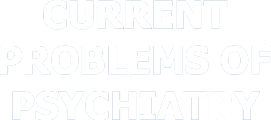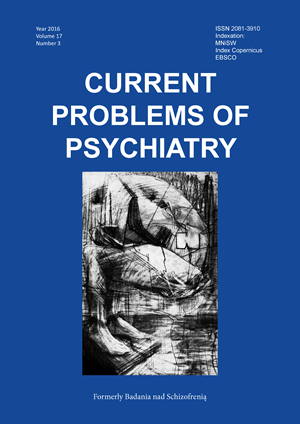“Skradzione macierzyństwo” - studium przypadku depresji poporodowej
DOI:
https://doi.org/10.1515/cpp-2016-0016Słowa kluczowe:
depresja poporodowa, depresja okołoporodowaAbstrakt
Cel: Celem pracy jest analiza przypadku depresji poporodowej z objawami psychotycznymi, powikłanej próbą samobójstwa rozszerzonego.
Metody: Analiza przypadku klinicznego i dokumentacji medycznej pacjenta.
Wyniki: U 25 letniej pacjentki, dwa tygodnie po urodzeniu dziecka, wystąpił epizod depresji poporodowej. W dalszym przebiegu choroby dołączyły się objawy psychotyczne (urojenia zgodne z nastrojem), myśli samobójcze oraz dotyczące zabicia dziecka w ramach samobójstwa rozszerzonego. Cztery miesiące po porodzie pacjentka zabiła swoje dziecko, a następnie podjęła nieudaną próbę samobójczą. Na postawie wywiadu zidentyfikowano u badanej szereg czynników ryzyka depresji poporodowej:1. położnicze i związane z dzieckiem: poród przez cięcie cesarskie, wcześniactwo, komplikacje położnicze w okresie ciąży, trudny temperament dziecka, problemy z karmieniem piersią; 2. psychologiczne: smutek poporodowy, wysoki poziom lęku w okresie ciąży, wysoki poziom stresu związanego z opieką nad dzieckiem.
Wnioski: Ważnym elementem prewencji depresji poporodowej jest psychoedukacja kobiet oraz ich rodzin. Należy również uczulić na ten problem tych pracowników służby zdrowia, którzy mają najczęstszy kontakt z matkami po porodzie: położne środowiskowe, ginekologów, pediatrów.
Bibliografia
1. Gavin, N., I. Gaynes, B. N. Lohr, K. N. Meltzer-Brody, S. Gartlehner, G. Swinson, T. Perinatal depression: a systematic review of prevalence and incidence. Obstet Gynecol.2005; 106(5,1):1071-1083.
2. Norhayati M. N., Hazlina N. N. Asrenee, A. R. Emilin, W.W. Magnitude and risk factors for postpartum depression. A literature review. J Affect Disord. 2015;1(175): 34-52.
3. Pużyński S., Wciórka J. Klasyfikacja zaburzeń psychicznych i zaburzeń zachowania ICD-10. Opisy kliniczne i wskazówki diagnostyczne. Uniwersyteckie Wydawnictwo Medyczne Vesalius. Instytut Psychiatrii i Neurologii. Kraków-Warszawa:2000.
4. Wciórka J. Kryteria diagnostyczne według DSM-IV-TR. Elsevier Urban and Partner. Wrocław:2008.
5. Rybakowski J., Dudek J., Jaracz D., Choroby afektywne w: Stan-dardy leczenia farmakologicznego niektórych zaburzeń psychicznych. red. Jarema M. Via Medica. Gadańsk:86-87:2015.
6. Munk-Olsen T., Laursen T. M., Pedersen C. B., Mors O., Mortensen, P. B. New parents and mental disorders: a population-based register study. JAMA. 2006;296(21):2582-2589.
7. Wisner K., Sit D. K., McShea M. C., Rizzo D. M., Zoretich R. A., Hughes C. L. Onset timing, thoughts of self-harm, and diagnoses in postpartum women with screen-positive depression findings. JAMA Psychiatry.2013;70(5):490-498.
8. Gerhant, M. Olajossy, A. Kalińska, A. Miernicka, Sharma V., Mazmanian D. The DSM-5 peripartum specifier: prospects and pitfalls. Arch Womens Ment Health. 2014; 17(2):171-173.
9. Reck C., Stehle E., Reinig K., Mundt C. Maternity blues as a predictor of DSM-IV depression and anxiety disorders in the first three months postpartum. J Affect Disord.2009; 113(1):77-87.
10. Bothan P. Postpartum mood disorders - a practitioner's guide to diagnosis and treatment. South African Journal of Psychiatry.2015; 9(1), 6-8
11. Spinelli M. G. Postpartum psychosis: detection of risk and management. Am J Psychiatry.2009;166(4):405-408.
12. Akiskal H. S., Walker P., Puzantian V. R., King D., Rosenthal T. L., Dranon M. Bipolar outcome in the course of depressive illness: phenomenologic, familial, and pharmacologic predictors. J Affect Disord.1983; 5(2): 115-128.
13. Sharma V., Khan M. (2010). Identification of bipolar disorder in women with postpartum depression. Bipolar Disord. 2010;12(3):335-340.
14. Freeman M. P., Smith K. W., Freeman S. A., McElroy S. L., Kmetz G. E., Wright R., Keck Jr. P. E.. The impact of reproductive events on the course of bipolar disorder in women. J Clin Psychiatry, 2002;63(4), 284-287.
15. Viguera A. C., Tondo L., Koukopoulos A. E., Reginaldi D., Lepri B., & Baldessarini R. J. (2011). Episodes of mood disorders in 2,252 pregnancies and postpartum periods. Am J Psychiatry. 2011;168(11):1179-85
16. Rybakowski J., Suwalska K., A., Lojko D., Rymaszewska J., Kiejna A.. Types of depression more frequent in bipolar than in unipolar affective illness: results of the Polish DEP-BI study. Psychopathology, 2007;40(3): 153-158.
17. Azorin J. M., Angst J., Gamma A., Bowden, C. L., Perugi G., Vieta E.,Young A. Identifying features of bipolarity in patients with first-episode postpartum depression: findings from the international BRIDGE study. J Affect Disord.2012; 136(3): 710-715.
18. Vliegen N., Casalin S., Luyten P. (2014). The course of postpartum depression: a review of longitudinal studies. Harv Rev Psychiatry.2014;22(1):1-22.
19. Kammerer M., Marks M. N., Pinard C., Taylor A., von Castelberg B., Künzli H., Glover, V. Symptoms associated with the DSM IV diagnosis of depression in pregnancy and post partum.Arch Womens Ment Health. 2009;12(3):135-141.
20. Pitt B. "Atypical" depression following childbirth. Br. J. Psychiatry, 1968;114(516):1325-1335
21. Hendrick V., Altshuler L., Strouse T., Grosser S. Postpartum and nonpostpartum depression: differences in presentation and response to pharmacologic treatment. Depress Anxiety. 2000;11(2):66-72.
22. Bernstein I. H., Rush A. J., Yonkers K., Carmody T. J., Woo A., McConnell K.,Trivedi, M. H.. Symptom features of postpartum depression: are they distinct?. Depress Anxiety.2008; 25(1):20-26.
23. Beck C. T., Indman P. The many faces of postpartum depression. J Obstet Gynecol Neonatal Nurs.2005;34(5):569-576.
24. Dalton K.. Depression after delivery . Oxford, UK: Oxford University Press 1996
25. Lindahl V., Pearson J. L.,Colpe L. Prevalence of suicidality during pregnancy and the postpartum. Arch Womens Ment Health. 2005;8(2):77-87.
26. Howard L. M., Flach C., Mehay A., Sharp D., Tylee A. The prevalence of suicidal ideation identified by the Edinburgh Postnatal Depression Scale in postpartum women in primary care: findings from the RESPOND trial. BMC Pregnancy Childbirth, 2011; 3(11):57.
27. Johannsen B. M. W., Larsen J. T., Laursen T. M., Bergink V., Meltzer-Brody S., Munk-Olsen T. (2016). All-cause mortality in women with severe postpartum psychiatric disorders. Am J Psychiatry.2016 ;3 (in press).
28. Wisner K. L., Peindl K. S., Hanusa B. H. Obsessions and compulsions in women with postpartum depression.J Clin Psychiatry 1999;60(3):176-80
29. Wisner K. L., Peindl K. S., Hanusa B. H. Psychiatric episodes in women with young children. J Affect Disord.1995;34(1),:1-11.
30. Barr J. A., & Beck C. T. Infanticide secrets Qualitative study on postpartum depression. Can Fam Physician, 2008;54(12):1716-1717.
31. Beck C. T., Records K., Rice M. Further Development of the Postpartum Depression Predictors Inventory-Revised. J Obstet Gynecol Neonatal Nurs 2006;35(6), 735-745.
32. Webster J., Pritchard M. A., Creedy D., East, C. A simplified predictive index for the detection of women at risk for postnatal de-pression.Birth, 2003;30(2):101-108.
33. Krzyżanowska-Zbucka J. Problemy emocjonalne kobiet w okresie okołoporodowym. Fundacja Rodzić po Ludzku, Warszawa, 2008
34. Kettunen P., Koistinen E., Hintikka J. Is postpartum depression a homogenous disorder: time of onset, severity, symptoms and hopelessness in relation to the course of depression. BMC Pregnancy and Childbirth, 2014;10(14):402
35. Austin M. P., Tully L., Parker G. Examining the relationship between antenatal anxiety and postnatal depression. J. Affect Disord.2007;101(1):169-174.
36. Lee A. M., Lam S. K., Lau S. M. S. M., Chong C. S. Y., Chui H. W., Fong D. Y. T. Prevalence, course, and risk factors for antenatal anxiety and depression. Obstet Gynecol. 2007;110(5):1102-1112.
37. Huizink A. C., Mulder E. J., de Medina, P. G. R., Visser G. H.,Buitelaar J. K. Is pregnancy anxiety a distinctive syn-drome?. Early Human Dev.2004; 79(2):81-91.
38. Smith-Nielsen J., Steele H., Mehlhase H., Cordes K., Steele M., Harder S.,Væver M. S. Links Among High EPDS Scores, State of Mind Regarding Attachment, and Symptoms of Personality Disorder. J Pers Disord, 2015;29(6):771-793.
39. Apter G., Devouche E., Gratier M., Valente M., Le Nestour A. (2012). What lies behind postnatal depression: is it only a mood disorder?. J Pers Disord.2012;26(3), 357.
40. Fonseca A., Gorayeb R., Canavarro M. Women C.׳ help-seeking behaviours for depressive symptoms during the perinatal period: Socio-demographic and clinical correlates and perceived barriers to seeking professional help. Midwifery, 2015;31(12):1177-1185.
41. Dennis C. L., Chung Lee L. Postpartum depression help-seeking barriers and maternal treatment preferences: A qualitative systematic review. Birth, 2006;33(4):323-331.
42. Goodman J. H. Women’s attitudes, preferences, and perceived barriers to treatment for perinatal depression. Birth, 2009;36(1):60-69.
43. Bilszta J., Ericksen J., Buist A., Milgrom J. Women's experience of postnatal depression - beliefs and attitudes as barriers to care. Austalian Journal of Advanced Nursing. 2010;27(3):44-54.
44. Horowitz A., Cousins A. Postpartum depression treatment rates for at-risk women. Nurs Res. 2006:55(2):23-27.
45. Hendrick V., Altshuler L., Strouse T., & Grosser S.. Postpartum and nonpostpartum depression: differences in presentation and response to pharmacologic treatment. Depress Anxiety, 2000;11(2):66-72.
46. De Crescenzo F., Perelli F., Armando M., Vicari S. Selective serotonin reuptake inhibitors (SSRIs) for post-partum depression (PPD): a systematic review of randomized clinical trials. J Affect Disord.2014;152, 39-44.
47. Molyneaux E., Howard L. M., McGeown H. R., Karia A. M., Trevillion K. Antidepressant treatment for postnatal depression. Advances in Psychiatric Treatment, 2014; 20(6):368-368.
48. Sharma V., Sommerdyk C. Are antidepressants effective in the treatment of postpartum depression? A systematic review. Prim. Care Companion CNS Disord. 2013;15 (6) PCC-13r01529.
Pobrania
Opublikowane
Numer
Dział
Licencja
Prawa autorskie (c) 2016 Autorzy

Praca jest udostępniana na licencji Creative Commons Attribution-NonCommercial-NoDerivatives 3.0 Unported License.


